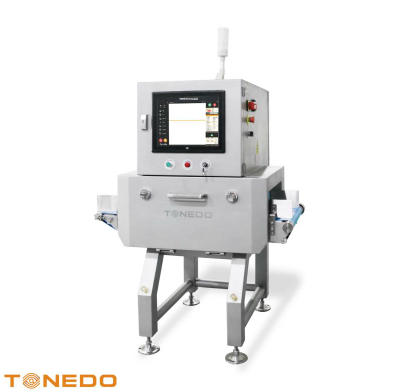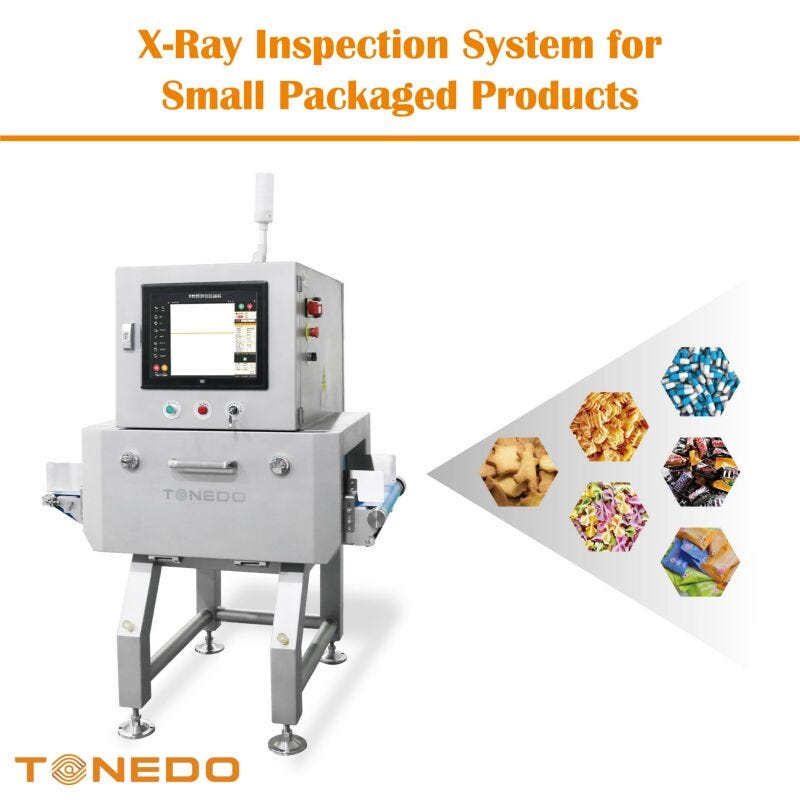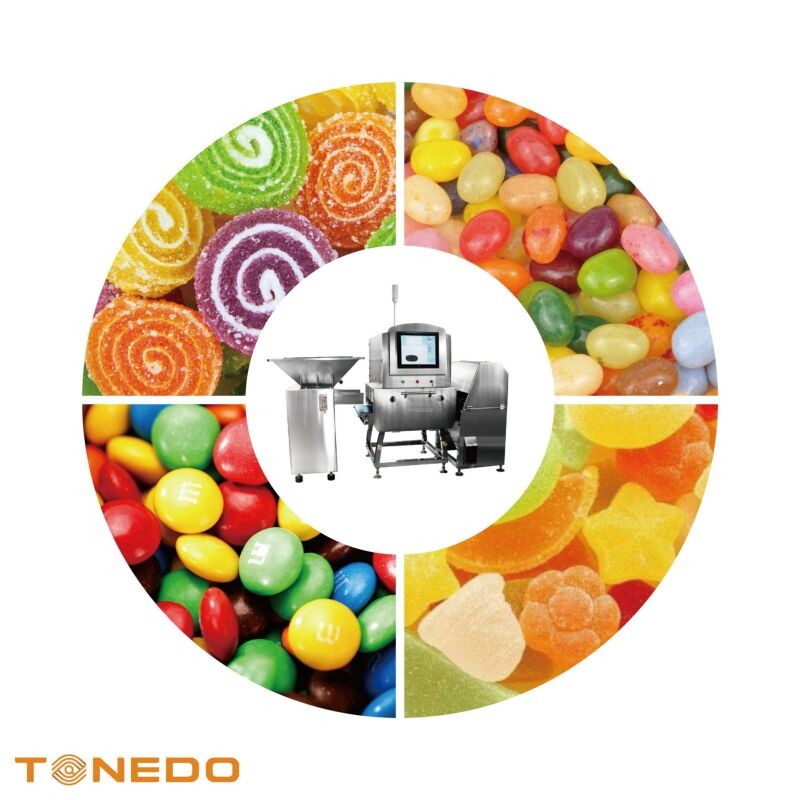FAQ about X-Ray Machine for Food
- 31 Jul, 2022
- 4656 vues

TTX-2411K100 Small Package X-Ray Machine
X-ray inspection system is becoming increasingly popular worldwide. This is likely due to two factors. First and foremost are the high costs associated with a food recall caused by foreign body contamination. Second, studies performed by the FDA and other organizations have concluded scanning food with X-ray scanners does not pose a health risk.
♦ Q1: What can an x-ray inspection system identify?
X-ray inspection systems can identify objects that are denser than water. The basic regulation is if it floats on water, it is much less dense than water. For instance, an x-ray system can locate hollow hearts in potatoes due to the fact that they are less thick than the bordering potato. Consequently, generally contaminants such as insects, wood or plastic can not be identified. There is a lot of irregularity with plastic. Plastics which are installed with barium are noticeable, pure plastic can not be seen.
X-ray inspection systems can spot all kinds of granite and also ceramic stone since it is denser than water. There are lots of types of stones with differing sizes, all of it relies on the thickness of their surrounding items for accurate detection. X-ray tools for food inspection can discover ferrous and non-ferrous steel because their thickness does not differ much in contrast to stainless-steel. Light weight aluminum can additionally be discovered depending upon its size as it is less thick versus various other steels. It can additionally identify calcium in bone and therefore detects bone. Calcium build-up happens quickly at time of death. The calcium viewed as brightness in a bone is what x-ray devices finds.
♦ Q2: Is x-ray food inspection equipment safe?
Yes, X-ray machine for food is safe. Equipments do not carry radiation resources. X-rays are created in the equipment by firing electrons at a Tungsten target that produces x-rays. When the x-ray is off, there is no radiation present. Our brand-new infographic shows some intriguing x-ray safety truths.
Food x-ray inspection systems do not use radioactive materials that pose a safety hazard to produce x-ray images. The X-rays used for “radiography” are produced by an electronically controlled X-ray tube. The beam is directed at the object it is examining, while a digital detector on the other side of the object produces an image for analysis. One advantage of this system over systems using radioactive sources is that once the X-ray tube is turned off, the X-ray energy stops immediately.
That said, of course, food x-ray systems will always produce ionizing radiation, so it is important to know the safety levels of radiation, the regulations that may apply, the safety equipment that meets those regulations, and the safeguards that are put in place during the manufacturing and installation process to ensure that all aspects are completely safe. In addition, the manufacturer takes every measure to limit exposure by installing mechanical shielding and protective curtains at the entrance and exit of the machine to further reduce radiation leakage. It is important that customers regularly inspect and maintain the curtains and replace them as they wear out.
♦ Q3: Do you require a great deal of space for x-ray examination even for small items?
The hesitance is reasonable: In the food industry particularly, room is always at a premium, especially when it concerns integrating new equipment right into existing production lines. While X-ray inspection devices absolutely require some amount of additional space, their overall impact on priceless floorspace can conveniently be mitigated.
An X-ray food inspection equipment can be downscaled to match the dimension of the items it examines. Such downsized versions are specifically designed for tiny items such as soup bags, grain bars, delicious chocolate or tiny trays. Despite their diminutive stature, these systems frequently deliver impressive throughputs without compromising precision or adaptability, making one component suitable for different small-item assessment applications.
♦ Q4: Can an x-ray equipment for food inspection check plan honesty?
That would certainly depend upon the bundle. Many food makers wish to explore a joint of the pouch as well as if your product has a great deal of salt in it, x-ray can find it conveniently. However, if your item is watery without much salt or spice, after that checking seal stability would certainly be hard. If dense food product gets trapped in the seal, then this can be found yet everything depends on the product.
♦ Q5: Is the greater the density, the higher the detectability?
It is commonly recognized that the performance of an X-ray inspection component mostly depends on the density of the foreign bodies it is entrusted with identifying. And also while this might hold true in some application situations, this size-centric view of detectability is by no implies a global commonness.
The truth is that the main particular that establishes the system’s absorption of radiation — as well as a result its detectability — is the international item’s atomic number. The more it “radiates,” the easier it is to discover; and while dimension has a tendency to enhance this characteristic, the full photo is much more complicated.
♦ Q6: Can x-ray inspection systems see if a bundle is open or closed?
X-ray in rigid applications with containers on a conveyor can validate if a lid is present. On boxed items all of it depends on the package. For non-rigid packaging such as foil or plastic bags the x-rays will certainly not work to check for open or closed plans.

Small Package X-Ray Machine
♦ Q7: What do the terms exposure and dose mean? What do their measurement units mean?
Exposure is a term defining the amount of ionizing radiation that strikes living or inanimate material. (This is a general definition. In health physics, exposure is specifically defined as a measure of ionization in air caused by x-ray or gamma radiation only.)
Dose means the quantity of radiation or energy absorbed. Dose may refer to the following:
ㆍabsorbed dose, the amount of energy deposited per unit mass.
ㆍequivalent dose, the absorbed dose adjusted for the relative biological effect of the type of radiation being meaasured.
Roentgen (R) is a unit of exposure of ionizing radiation and indicates the strength of the ionizing radiation. One Roentgen is the amount of x-ray needed to produce ions carrying 1 electrostatic unit of electrical charge in 1 cubic centimeter of dry air under standard conditions.
Roentgen absorbed dose (rad) is the basic unit of absorbed radiation dose. A dose of 1 rad to an object means each gram of the object received 100 ergs of energy or 1 rad = 100 ergs/gram.Roentgen Equivalent Man (rem) is the basic unit of equivalent dose, and relates the absorbed dose in human tissue to the biological effect of the radiation. Not all radiation has the same biological effect, even for the same amount of absorbed dose.
♦ Q8: Why does food need to be inspected by an X-ray inspection system?
Most unprocessed foods and ingredients come from natural environments such as fields, orchards, or farms. When food is harvested, foreign objects such as stones or glass are always picked up and transported to the processing plant. In addition, objects found in the production facility — such as metal and some very hard plastics — may enter the production line for mechanical or process failure reasons. These risks and associated costs are driving stricter regulatory requirements for foreign object detection worldwide. As a result, food processors are using X-ray inspection as part of their overall food safety programs to help ensure that the final product does not contain harmful foreign objects before it reaches the consumer.
♦ Q9: How do food x-ray detectors work?
Food x-ray inspection systems work based on product density and contaminants. x-rays are waves of light that are invisible to our naked eye and have very short wavelengths and very high energy. When X-rays penetrate food products, it loses some energy. Dense areas (e.g. containing contaminants) will further reduce the energy. As the X-rays leave the product, they reach the sensor. The sensor then converts the energy signal into an image of the inside of the food. Foreign objects are dark gray in color and help identify foreign contaminants.
♦ Q10: Can operators be exposed to radiation from food x-ray inspection systems?
Although the food x-ray system generates radiation during normal use, personnel operating the control panel with the x-ray food detector are not exposed to any radiation from the machine due to shielding protection. In fact, food x-ray inspection systems emit no more than 0.1 millirem (mrems) of radiation per hour and are usually located away from the operator’s entrance or exit. Based on a 40-hour work week and 50 weeks of work per year, multiplying 0.1 mrems per hour. means that even in the worst case scenario, workers may be exposed to a total of 200 mrems per year — well below the guideline for maximum exposure. The International Commission on Radiological Protection also states that people can absorb 5,000 mrems per year (eight times the natural dose) before radiation poses a health risk.
♦ Q11: How does the exposure from food x-ray screening systems compare to other sources of radiation?
In our daily lives, we are all exposed to naturally occurring background radiation. In fact, according to the U.S. Nuclear Regulatory Commission, natural radiation accounts for about half of the 620 mrems of radiation that the average person experiences each year. As we noted in the question above, the International Commission on Radiological Protection also states that people can absorb 5,000 mrems per year (eight times the natural dose) before radiation poses a health risk.
To fully understand the doses of x-ray radiation involved in food production, here are some average radiation doses that people receive from their daily experiences.
ㆍWhole body CT scan = 1,000 mrem
ㆍNature/Universe = 310 mrem / year
ㆍTransatlantic flight = 2.5 mrem
ㆍDental X-rays = 1.5 mrem
ㆍFood X-ray inspection = 0.1 mrem / hour*
This maximum radiation dose per hour that can be emitted by a food inspection system while the instrument is in operation is usually only the input/output at the detection port that will be very close to that dose. Since operators spend very limited time in that position, they will receive less (usually zero) radiation dose during an average work shift.
If you want to learn more about the X-ray inspection systems, please visit our website or consult us!
- Catégorie:
- Entreprise
- Pas de commentaires



